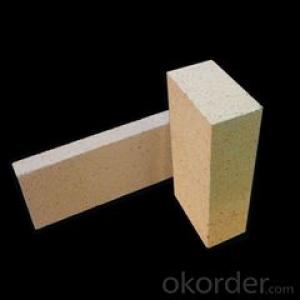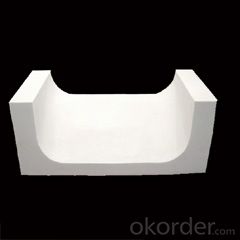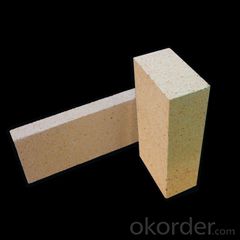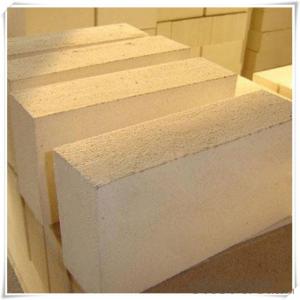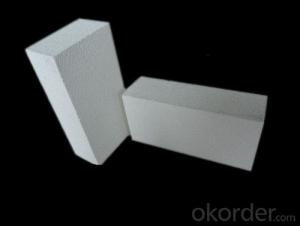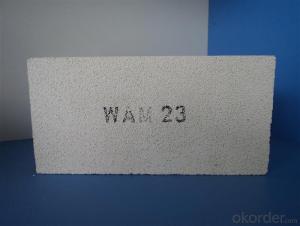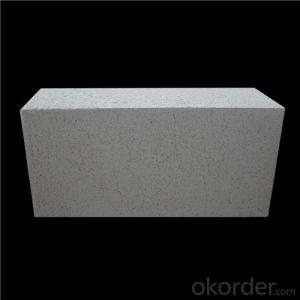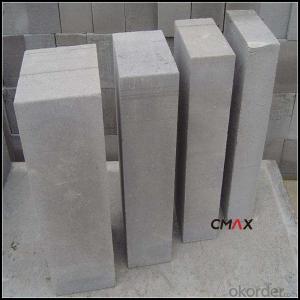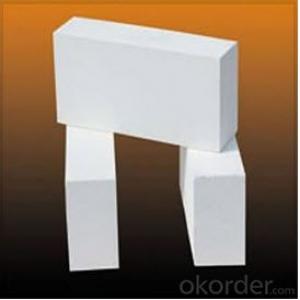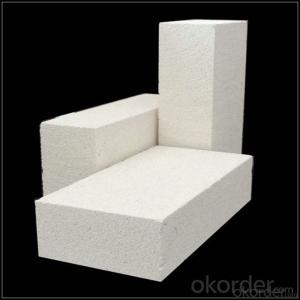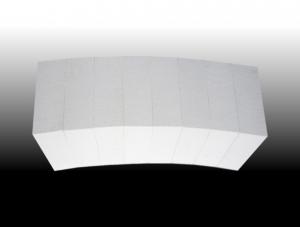Refractory Insulation Fire Brick, Insulating Fire Brick
- Loading Port:
- Shanghai
- Payment Terms:
- TT OR LC
- Min Order Qty:
- 10 m.t.
- Supply Capability:
- 100 m.t./month
OKorder Service Pledge
OKorder Financial Service
You Might Also Like
Quick Details
| Place of Origin: | Shape: | Brick | Material: | Alumina Block |
| SiO2 Content (%): | Al2O3 Content (%): | as usual | MgO Content (%): | general |
| CaO Content (%): | Refractoriness (Degree): | Common (1580°< Refractoriness< 1770°) | CrO Content (%): | 0 |
| SiC Content (%): | Model Number: | DLG, PLG | Brand Name: | |
| name: |
Packaging & Delivery
| Packaging Detail: | 1.The Insulating Fire Brick will be packed as the standard of exporting or packed on wooden pallet with three layers water-proof shrink film and tightened with plastic/steel bandages,when in the transportation process,we should pay attention to moisture-proof and light handling. 2.The packing of Refractory Brick will accept customer's requirement if any. 3.Delivery within 7-15 working days after your payment. 4.Fast delievery accepted by customers. |
| Delivery Detail: | within 20 days |
Refractory Bricks for Furnace
Product Description
We are a professional company which has manufactured bricks for more than25 years, we can supply Fire Caly brick, High alumina bick, Tunnel kiln car brick, Silica brick, Big block for glass furance and Coke Dry Quenching, calcined alumina powder and Kaolin. Our company is the direct maker and supplier inChina.
Fire brick, refractory brick, insulation brick, insulating fire brick, insulation refractory brick, fire bricks, refractory bricks, insulation bricks, insulating bricks, insulating fire bricks, insulator, fire proof brick, lining brick, hot face bricks, cold face bricks,
Two type of our Alumina Insulating Fire Brick (LG-IFB):
Ordinary type (PLG-IFB)
Low iron type (DLG-IFB)
Two produce methods of our LG-IFB:
Fast foam setting technology
Method of burning up adding object
Characteristics of our LG-IFB:
High cold crushing strength
High softing temperature under load
Accurate dimension
Good thermal shock resistance
Application:
Widely used in insulating layers of various thermal equipments and linings where no high temperature melt corrosion occurs.
| Item | PLG- 1.0 | PLG- 0.9 | PLG-0.8 | PLG-0.7 | PLG-0.6 | PLG-0.5 | |||
| Al2O3 ,% ≥ | 48 | ||||||||
| Fe2O3 ,%≤ | 2 | ||||||||
| BD(g/cm3) | 1.0 | 0.9 | 0.8 | 0.7 | 0.6 | 0.5 | |||
| CCS>(Mpa) | 4.50 | 4.00 | 2.94 | 2.45 | 1.96 | 1.47 | |||
| TC<(350±25ºC) | 0.55 | 0.50 | 0.35 | 0.30 | 0.25 | 0.20 | |||
| test temperature at PLC<2% ºC | 1400 | 1400 | 1400 | 1350 | 1350 | 1250 | |||
| tolerance of dimension(mm) | PLG-IFB | DLG-IFB |
| ≤100 | ±1.5 | ±1.0 |
| 101-250 | ±2 | ±1.0 |
| 251-400 | ±3 | ±1.5 |
| warpage(mm) | ||
| ≤250 | ≤1 | ≤0.8 |
| 251-400 | ≤1.5 | ≤1.0 |
| crack(mm) | ||
| ≤0.25 | unlimited | unlimited |
| 0.26-1.0 | 30 | 30 |
| >1.0 | rejected | rejected |
1.Raw materials blending
Independent raw materials blending center to assurestrict control of materials quality.
2.Shaping
Isostatic pressing technoloty,with as 1000 tons of pressure to assure the homogenous bulk density of each product.
3.Machining
To assure the uniform shape,dimension and dimension tolerance of each product.
4.X-ray defect inspection
To assure all products supplied to our customers without any defect and to prevent the un-countable feconomic loss for our customers.
5.Physical and chemistry analysis
To assure all products meet the physical and chemistry characteristics.
6.Packaging
The world-class for packaging to assure the safety transportation.
- Q: Do insulating fire bricks have low thermal conductivity?
- Yes, insulating fire bricks have low thermal conductivity.
- Q: Are insulating fire bricks resistant to sound transmission?
- Yes, insulating fire bricks are known to have good sound insulation properties and are resistant to sound transmission.
- Q: Can insulating fire bricks be cut or shaped as needed?
- It is possible to cut or shape insulating fire bricks according to one's needs. These bricks are manufactured using lightweight materials like ceramic fibers and refractory materials, which make them more easily cut and shaped compared to traditional dense fire bricks. Cutting them can be done effortlessly using a saw or a specialized cutting tool, while shaping can be achieved through grinding, sanding, or chiseling. The ability to cut and shape them gives the advantage of custom fitting the insulating fire bricks to specific applications or structures. However, it is crucial to emphasize that precautions must be taken for safety while cutting or shaping the bricks. Wearing protective goggles, gloves, and a dust mask is essential in order to prevent inhaling any hazardous particles.
- Q: Can insulating fire bricks be used for insulation in autoclaves?
- Yes, insulating fire bricks can be used for insulation in autoclaves. These bricks are designed to withstand high temperatures and provide excellent thermal insulation, making them suitable for use in autoclaves where temperature control and insulation are important.
- Q: Are insulating fire bricks resistant to warping?
- Yes, insulating fire bricks are resistant to warping. They are specifically designed to have high thermal stability and low thermal conductivity, which helps to prevent warping even under high temperatures.
- Q: Can insulating fire bricks be used in the construction of lime production linings?
- Yes, insulating fire bricks can be used in the construction of lime production linings. These bricks are designed to withstand high temperatures and provide insulation, making them suitable for lining furnaces and kilns used in lime production. They can help maintain the desired temperature, conserve energy, and improve the efficiency of the lime production process.
- Q: Can insulating fire bricks be used in refractory cement?
- Insulating fire bricks have the ability to be utilized in refractory cement. These bricks are specifically engineered to offer thermal insulation in situations that involve high temperatures. On the other hand, refractory cement is employed to establish a robust and long-lasting connection between bricks or other refractory materials. The combination of insulating fire bricks and refractory cement can enhance the overall thermal efficiency and insulation characteristics of the structure. This, in turn, can minimize heat loss and maximize system efficiency. It is crucial, however, to meticulously adhere to the manufacturer's instructions and guidelines to ensure appropriate installation and optimal performance when using insulating fire bricks and refractory cement in conjunction.
- Q: What are the insulation materials for heating buried pipelines?
- The heat preservation layer is composed of antirust paint, heat insulating material, moisture-proof layer (used for pipeline in the trench), protective layer, anticorrosive layer (used for trench or directly buried pipe) and top coat (or fireproof coating).The waterproof layer can be used asphalt or aluminum foil protective layer with glass cloth or galvanized steel.
- Q: Can insulating fire bricks be used in glass furnaces?
- Yes, insulating fire bricks can be used in glass furnaces. Insulating fire bricks are designed to have low thermal conductivity, which makes them ideal for use in high-temperature environments like glass furnaces. These bricks help to reduce heat loss from the furnace, resulting in improved energy efficiency and reduced operating costs. They also provide better insulation and help to maintain consistent temperatures inside the furnace, which is crucial for glass production. Additionally, insulating fire bricks have good resistance to thermal shock and can withstand the extreme temperatures and rapid temperature changes that occur in glass furnaces. Overall, the use of insulating fire bricks in glass furnaces can contribute to better furnace performance, increased productivity, and energy savings.
- Q: Can insulating fire bricks be used in the construction of thermal insulation roofs?
- Insulating fire bricks are indeed applicable in the construction of thermal insulation roofs. Their design is tailored to possess exceptional thermal insulation characteristics, rendering them a perfect option for heat retention and energy efficiency needs. These bricks are crafted from lightweight materials like clay, which exhibit low thermal conductivity and remarkable resistance to heat transfer. Consequently, they effectively minimize heat loss or gain, making them suitable for thermal insulation roofs. Moreover, insulating fire bricks showcase durability and the ability to endure high temperatures, establishing them as a dependable choice for long-lasting utilization in roofing applications.
Send your message to us
Refractory Insulation Fire Brick, Insulating Fire Brick
- Loading Port:
- Shanghai
- Payment Terms:
- TT OR LC
- Min Order Qty:
- 10 m.t.
- Supply Capability:
- 100 m.t./month
OKorder Service Pledge
OKorder Financial Service
Similar products
Hot products
Hot Searches
Related keywords

